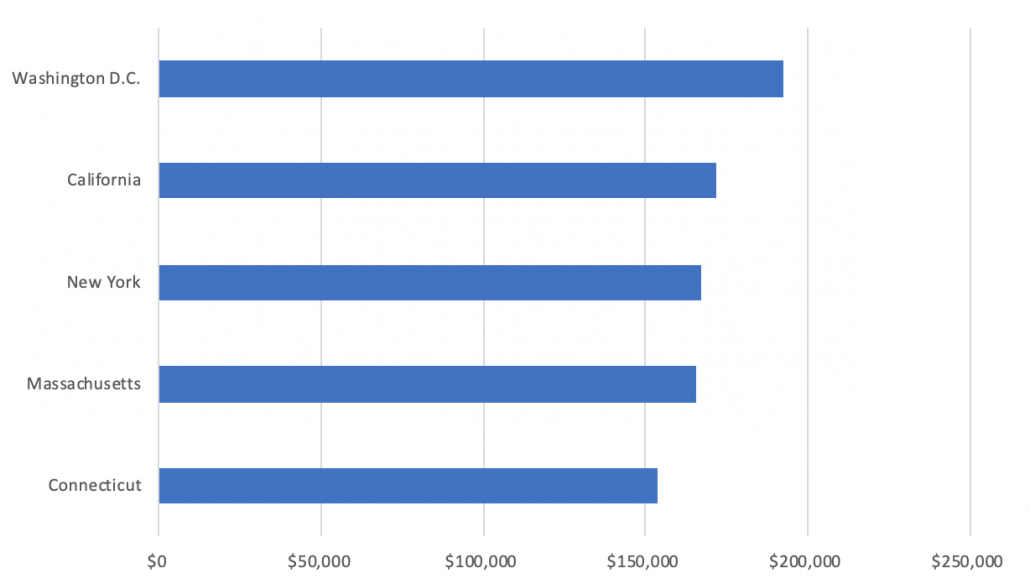Average Lawyer Salaries
The average salary of a lawyer can be an important consideration when you are deciding what industry you want to work in or whether you want to pursue a law degree. There are many factors to weigh when considering becoming a lawyer, and knowing about how much money you might make can help with financial planning and give you a good estimate of when you can expect to pay off your law school loans.
According to the U.S. Bureau of Labor Statistics, lawyers in the United States earned a median of $120,910 in 2018.
[ RELATED: How long is law school? ]
Top Earning States for Lawyers
Here are the top 5 states ranked by average income for lawyers:

Expand for specific numbers by state:
- Washington D.C.: $192,530
- California: $171,550
- New York: $167,110
- Massachusetts: $165,610
- Connecticut: $153,640
Top Earning Metro Areas for Lawyers
The numbers above represent state-wide averages. Average salaries for lawyers in metropolitan areas tend to be higher. Here are the top 10 metro areas in which lawyers are paid the highest average annual salary, according to the U.S. Bureau of Labor Statistics.
According to U.S. Bureau of Labor Statistics, top 10 metro areas are (by mean salary):
- San Jose-Sunnyvale-Santa Clara, CA: $207,950
- San Francisco-Oakland-Hayward, CA: $183,070
- Washington-Arlington-Alexandria, DC-VA-MD-WV: $179,980
- Los Angeles-Long Beach-Anaheim, CA: $176,020
- Houston-The Woodlands-Sugar Land, TX: $175,380
- Oxnard-Thousand Oaks-Ventura, CA: $172,900
- New York-Newark-Jersey City, NY, NJ, PA: $172,020
- Bridgeport, Stamford, Norwalk, CT: $171,690
- Boston-Cambridge-Nashua, MA-NH: $170,720
- Sheboygan, WI: $170,350
The top-paying non-metropolitan areas, according to the U.S. Bureau of Labor Statistics, are as follows:
- North Valley-Northern Mountains Region of California: $159,320
- West Texas Region of Texas: $153,490
- Central New Hampshire: $130,300
- Arizona Nonmetropolitan Area: $127,210
- Alaska Nonmetropolitan Area: $126,940
Lawyer Wage Gap Between Men and Women
Parallelling a national trend across all fields, male lawyers tend to earn more than female lawyers. The U.S. Bureau of Labor Statistics reported that in 2018, female lawyers’ weekly salary was about 80% of male lawyers’ weekly salary. This gap, however, is narrowing each year; in 2006, female lawyers earned just 70.5% of what their male counterparts earned.
Choosing an Industry
The annual mean wages for the top-paying industries for law, according to the U.S. Bureau of Labor Statistics, are as follows:
- Cable and other subscription programming: $234,310
- Pipeline transportation of crude oil: $215,700
- Motor vehicle manufacturing: $205,610
- Computer and peripheral equipment manufacturing: $204,710
- Petroleum and coal products manufacturing: $200,830
As of May 2018, the median annual earnings for the four industries with the highest level of employment for lawyers are as follows:
- Federal government: $145,160
- Legal services: $122,150
- Local government, excluding education and hospitals: $94,490
- State government, excluding education and hospitals: $86,900
Lawyers who own their own practices usually make less than lawyers who work in law firms or other companies.
Public vs. Private Sector Earnings
Whether you work in the public or the private sector will affect your potential earnings significantly. According to the National Association for Law Placement, the median annual salaries for public service attorneys are as follows:

Source: National Association for Law Placement, “Median Salaries for Lawyers by Type of Organization and Years of Experience–2004-2018”
When compared to the national median income for lawyers ($120,910), it’s clear that private-sector lawyers make significantly more than those working in public service. In 2018, the median income for private-sector attorneys was more than double that of the highest median figures for entry-level public-sector lawyers.
[ NEXT: Law School Admissions: Choosing a Law School ]


